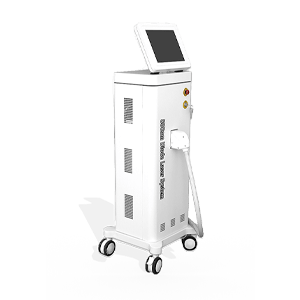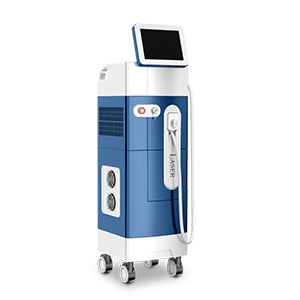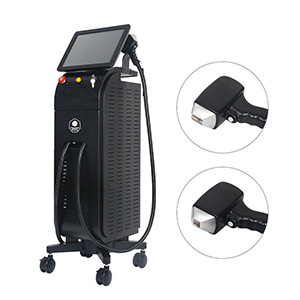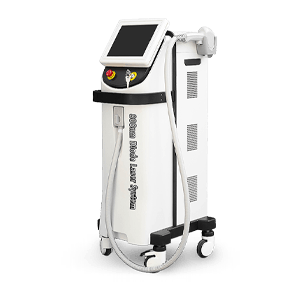Laser Hair Removal
Laser hair removal solutions achieve maximum results for all areas of the body with treatments.
Getting rid of unwanted hair is an age-old issue, with long-term hair removal being particularly challenging.
As a laser machine manufacturer, PrettyLasers’s FHR hair removal method uses groundbreaking technology to offer a simple, one-stop solution for truly effective hair removal.
FHR’s unique hair removal method effectively damages the hair follicles while avoiding injury to the surrounding skin. The sweeping Fast Hair Removal delivery technique keeps the laser in constant motion ensuring full coverage.
Simultaneous contact cooling prevents burns and allows for more comfortable treatment and a specialized applicator allows you to treat large areas in less time.
Whether you have light, dark or tanned skin, coarse or fine hair, PrettyLasers’s hair removal solutions achieve maximum results for all areas of the body with treatments that are safe, quick, and best of all virtually painless.
Laser hair removal is the method of hair removal that suggests that exposure to pulses of optical maser light-weight destroy the follicle. It had been performed by experimentation for concerning twenty years before turning commercially accessible in 1995 and 1996. one in all the primary revealed articles describing optical maser hair removal was authored by the cluster at Massachusetts General Hospital in 1998. optical maser hair removal is widely practiced in clinics, and even in homes victimization devices designed and priced for shopper self-treatment. several reviews of optical maser hair removal ways, safety, and effectiveness are revealed within the medical literature
How does it work?
The primary principle behind laser hair removal
The primary principle behind laser hair removal is selective photothermolysis (SPTL), the matching of a specific wavelength of light and pulse duration to obtain optimal effect on a targeted tissue with minimal effect on surrounding tissue. Lasers can cause localized damage by selectively heating dark target matter, melanin, thereby heating up the basal stem cells in the follicle which causes hair growth, the follicle, while not heating the rest of the skin. Light is absorbed by dark objects but reflected by light objects and water, so laser energy can be absorbed by dark material in the hair or skin, with much more speed and intensity than just the skin without any dark adult hair or melanin.
Melanin
The Melanin is considered the primary chromophore for all hair removal lasers currently on the market. Melanin occurs naturally in the skin and gives skin and hair their color. There are two types of melanin in the hair. Eumelanin gives hair brown or black color, while pheomelanin gives hair blonde or red color. Because of the selective absorption of photons of laser light, only hair with colors such as black, brown, or reddish-brown hair or dirty blonde can be removed. White hair, light blonde, and strawberry blonde hair do not respond well. The laser works best with dark coarse hair. Light skin and dark hair are an ideal combination, being most effective and producing the best results, but lasers such as the Nd: YAG laser are able to target black hair in patients with dark skin with some success.
Permanent hair reduction
Hair removal lasers have been in use since 1997 and have been approved for “permanent hair reduction” in the United States by the Food and Drug Administration (FDA). Under the FDA’s definition, “permanent” hair reduction is the long-term, stable reduction in the number of hairs regrowing after a treatment regime. Indeed, many patients experience complete regrowth of hair on their treated areas in the years following their last treatment. This means that although laser treatments with these devices will permanently reduce the total number of body hairs, they will not result in the permanent removal of all hair.
Laser hair removal has become popular because of its speed and efficacy, although some of the efficacy is dependent upon the skill and experience of the laser operator, and the choice and availability of different laser technologies used for the procedure. Some will need touch-up treatments, especially on large areas, after the initial set of 3-8 treatments.
FHR IS PrettyLasers’ PROPRIETARY HAIR REMOVAL METHOD USED IN CLINICS AROUND THE WORLD WITH GLOBAL BRAND RECOGNITION.
Fast Hair Removal
FHR is suitable for public treatment, easy to start treatment, most popular with beauticians in beauty salons, spa centers, etc.
A high repetition rate of short pulses is delivered deep into the dermis, achieving high average power and therapeutically effective heat build-up, with virtually no pain.
TEC + Sapphire Contact Cooling Technology
The sweeping In-motion technique of moving the applicator repeatedly over the treatment area ensures full coverage while TEC + Sapphire Contact Cooling Technology cools the skin surface – preventing superficial burns and allowing for virtually painless, yet highly effective hair removal.

Laser Hair Removal Reviews:
Diode Laser Hair Removal Risks and Safety
Professional Laser hair removal doesn’t guarantee permanent hair removal. Some hair could be resistant to the laser treatment or grow again after treatment — although the new hair growth might be finer and lighter in color.
Possible laser hair removal side effects include:
- Mild swelling around the hair follicles
- Pigment changes may occur, especially in those with darker skin. These changes are usually temporary
Slight redness of the skin - Temporary irritation resulting in blistering, crusting, scarring, or other changes in skin texture
- Special care must be taken for those with darker skin. A less intensive laser should be used to avoid damaging the outer skin. Anyone who has tanned, used a spray tan, or gone to a tanning booth should wait until the tan has faded as the pigment in the skin absorbs the laser light and reduces the effectiveness of the treatment. These risks and others will be fully discussed prior to your consent. It’s important that you address all your questions directly with your laser machine manufacturer.
These are suggestions for before and after treatment care. You should always consult your physician for appropriate before and aftercare for any laser treatments.
Before and After Care for Diode Laser Hair Removal
Before your treatment:
- Hair should be cleanly shaven Leave a representative sample unshaven for the clinician to assess
- Do not wear makeup on the treated area the day of treatment
- No sun-tanning or self-tanners 4 weeks prior to treatment Includes spray tans, tanning lotions, tanning beds, sun exposure, etc.
- Some medications or supplements may increase the risk of bruising. Consult with your physician
- No waxing, plucking, or tweezing at least 4 weeks prior to treatment Some body parts may require a longer wait time
- Avoid treatments that may irritate the skin for 1-2 weeks prior to treatment (depilatories, harsh chemicals, etc.)
- Notify the clinic of any changes to your health history or medications since your last appointment
- History of herpes or cold sores may require an anti-viral prescription prior to treatment
After your treatment:
- Avoid sun exposure and use a broad-spectrum (UVA/UVB) sunscreen
- Redness and perifollicular edema (looks like a rash/bug bites) are common and resolve with time
- Bruising and swelling are less common but may occur and will resolve with time
- Hair may take up to 2 weeks to fall out
- Avoid heat – hot tubs, saunas, etc. for 1-2 days
- Avoid skin irritants (examples below) a few days post-treatment products containing tretinoin, retinol, benzoyl peroxide, glycolic/salicylic acids, astringents, etc.
- Do not wax or pluck between treatments
- Notify the clinic of any concerns (blistering, excessive redness/swelling, etc.)
- Hair removal requires a series of treatments. The number of treatments depends on body location and type of hair.
- Consult with the clinic about when to resume skincare regime
- Hair grows in different phases and not all at the same rate. This is why multiple sessions of laser hair removal are necessary to achieve hair reduction. Targeting the hair in the appropriate stage of growth with thermal damage from the laser is how effective hair reduction is achieved
How many treatments will I need?
Most treatments require 4-6 sessions for permanent hair removal in any one area. The procedure can be repeated at monthly intervals.
How much does laser hair removal cost?
Laser hair removal costs £100 depending on the area treated.




